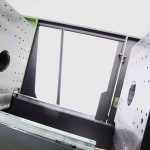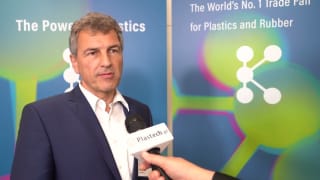
25 years of Engel tie-bar-less technology
'The clamping unit of an injection moulding machine has four tie-bars.' Since the first single-screw injection moulding machine was developed in 1956, this design principle was regarded as inviolable – but when Engel unveiled a tie-bar-less machine at the K 1989 plastics trade show in Düsseldorf, the innovation by the Upper Austrian company was greeted with astonishment and even ridicule; there were plenty of arguments against it. Twenty-five years on, tie-bar-less injection moulding machines represent one of Engel's biggest revenue sources. Underlining the outstanding success of the new design principle, more than 60,000 tie-bar-less machines have been delivered around the world. Machines offering large platen faces and free access to the mould area meet the need for high efficiency and cost-effectiveness in injection moulding production more closely than any other design. Now Engel is set to celebrate this success story with a special presentation in the East Foyer at Fakuma 2014.An Engel victory 330/80 tech injection moulding machine fitted with energy efficient ecodrive drive technology and the new CC300 control unit will produce fittings for drainage systems – an application designed to showcase the advantages of tie-bar-less technology to best effect. Although the mould provided by ifw-Kunststofftechnik (Micheldorf, Austria) is of substantial size with its large core-pulls, it can still be attached to the 80-ton machine quickly and conveniently. "When you used a traditional machine with tie-bars, a large machine with minimum clamping force of 150 tons would be needed to fit the bulky mould. You would also need to remove a tie-bar or disassemble the core-pulls to set up the mould, which took a lot of time," says Franz Pressl, Product Manager for tie-bar-less Engel victory injection moulding machines. With no tie-bars to interfere with the mould in the Engel victory, mould mounting platens can be used up to their edges and very large moulds can be mounted on relatively small injection moulding machines. "This enhances overall efficiency," says Pressl. "Smaller machines require less energy, and most importantly take up less space."
Machines with no tie-bars offer particular benefits in the production of large components with complex, three-dimensional structures as well as multi-component applications; they are also advantageous in the case of multi-cavity moulds. "Because of the pressure of costs in many sectors, the number of cavities is rising and moulds are getting bigger. Compared to mould size, though, the actual clamping force requirement has remained relatively low in the production of technical parts," underlines Franz Pressl. "Tie-bar-less technology has enabled us to turn the tide of spiralling costs and make plastics processing firms more competitive by installing smaller machines. Even in its 25th year, tie-bar-less technology has its finger on the pulse."




